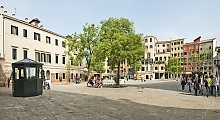A city you have to visit at least once in a lifetime. Historic, magnificent, lively and full of tourists. Nevertheless, Venice is not just St. Mark's Square and Rialto Bridge. If we turn to the empty streets and get lost in the side channels, we will soon find out that in the city, apart from tourists, there are also Venetians. You can not believe it, it's true. Old houses, flowers on the windows and linen lined between the houses. Somewhere an elderly lady comes with a shopping bag and on the other hand a boy walks on the empty street.
So we spent one day exploring things that are not exactly on the ordinary path for all the day-to-day visitors to the city. For a good start, we were away from the crowd of tourists who drank a great expekt for a bar of € 1, went for lunch to a paninie for € 1 and drank children to € 0.80 per month. What we want you to do for the better, the gray and the good will, we went on a walk to the Jewish quarter.
Venice also has its own Jewish quarter. ghetto, who is still alive after about 500 years. At the beginning of the 16th century, the Venetian Republic assigned to the judiciary this area where Venetian foundries were in which the Jews could also work. Another possibility of earnings was the sale of used things. The quartet itself was closed between six o'clock in the evening and twelve o'clock in the morning, so that the Jews could not walk outside the ghetto during this time. During this time, the surroundings were guarded by Venetian guards. Thus, the first ghetto was born in Europe. After the fall of the Venetian Republic, Napoleon ordered the judiciary citizens' rights and equated them with other citizens. All this took place until September 1938, when their rights were taken away and a difficult period for the Holocaust began for the Jewish community, which was here before the war as many as two thousand people.
Today, the quarter is lively and is a popular district of the city with religious and administrative institutions of the Jewish community and five synagogues. The buildings themselves are higher than elsewhere in Venice, because they were built by the Jews because of the lack of space. In the main square there are: fountain, memorial tiles and memorial plaque to the victims of the Holocaust. Under the tree in the middle of the square is a pleasant shade for rest, but opposite is a restaurant that could be interesting. Follow the signs of the synagogue and come to an empty street. Here are two of the oldest synagogues, but at first glance they are not separated from other high houses. The synagogues were not supposed to stand out from the surroundings, and if you do not ask the sales people about where they are, it's impossible to recognize them. There is also a museum in the area, which is not quite large, but certainly offers a look at the history of the Jews in Venice between the 16th and 19th centuries. Within the museum offer guided tours of the synagogue, museum and cemetery. But beware, on the Sabbath, Judas Shabbat do not work.
So, for the next time, you have one more idea of what to see in Venice, but we headed back to the coast and went on to the islands of Burano and Murano, and this may be the next time.
VENICE JEWISH QUARTER







